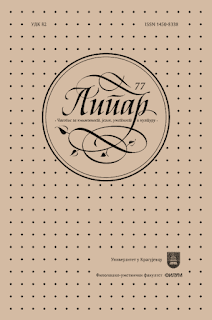ГРЕШКЕ У УПОТРЕБИ ОДРЕЂЕНОГ ЧЛАНА ИЗАЗВАНЕ НЕГАТИВНИМ ТРАНСФЕРОМ ТОКОМ УЧЕЊА ТИПОЛОШКИ СЛИЧНИХ ЈЕЗИКА (СЛУЧАЈ ИТАЛИЈАНСКОГ КАО Л2 И ШПАНСКОГ КАО Л3 ИЗ ПЕРСПЕКТИВЕ СРБОФОНИХ ГОВОРНИКА)
ERRORS IN THE USE OF THE DEFINITE ARTICLE CAUSED BY NEGATIVE TRANSFER DURING ACQUISITION OF TYPOLOGICALLY SIMI- LAR LANGUAGES (THE CASE OF ITALIAN AS L2 AND SPANISH AS L3 FROM THE PERSPECTIVE OF SERBIAN SPEAKERS)
Author(s): Marija N. VujovićSubject(s): Language and Literature Studies, Theoretical Linguistics, Applied Linguistics, Comparative Linguistics, Sociolinguistics, Translation Studies
Published by: Универзитет у Крагујевцу
Keywords: definite article;transfer;language distance;psychotypology;proficiency;L2/L3;plurilingual speakers;Spanish;Italian;Serbian
Summary/Abstract: After numerous studies on the role of transfer which occurs during the second language acquisition, in the last few decades the focus of research has shifted to the role of transfer during the third language acquisition, as it has been proved that the mechanisms of L3 acquisition, due to their complexity, represent a completely different process from L2 acquisition. It has also been proved that (negative) transfer is the most evident in typologically similar languages. This paper examines the errors related to the use of the definite article made by native speak- ers of Serbian who learn Italian as L2 and Spanish as L3, and caused by negative transfer. In order to identify errors, we examined three factors that may affect transfer: language distance, psychotypology and proficiency. The results show that the errors concern both the form and the use of the definite article due to the strong negative transfer from Italian to Spanish. The most common errors present in the interlanguage of the students were interlingual rather than intralingual. Moreover, it has been proved that the number of errors decreased as the knowledge of L3 and L2 grew. Although it was not possible to examine the impact of L1 on the L3 learning process since the definite article does not exist in Serbian, the fact is that mistakes in written production in Spanish would not have been made if students had not previously studied Italian. In other words, interlingual similarities caused the most errors and favored negative transfer from the second to the third language.
Journal: Липар - часопис за књижевност, језик, уметност и културу
- Issue Year: XXIII/2022
- Issue No: 77
- Page Range: 77-97
- Page Count: 21
- Language: Serbian

